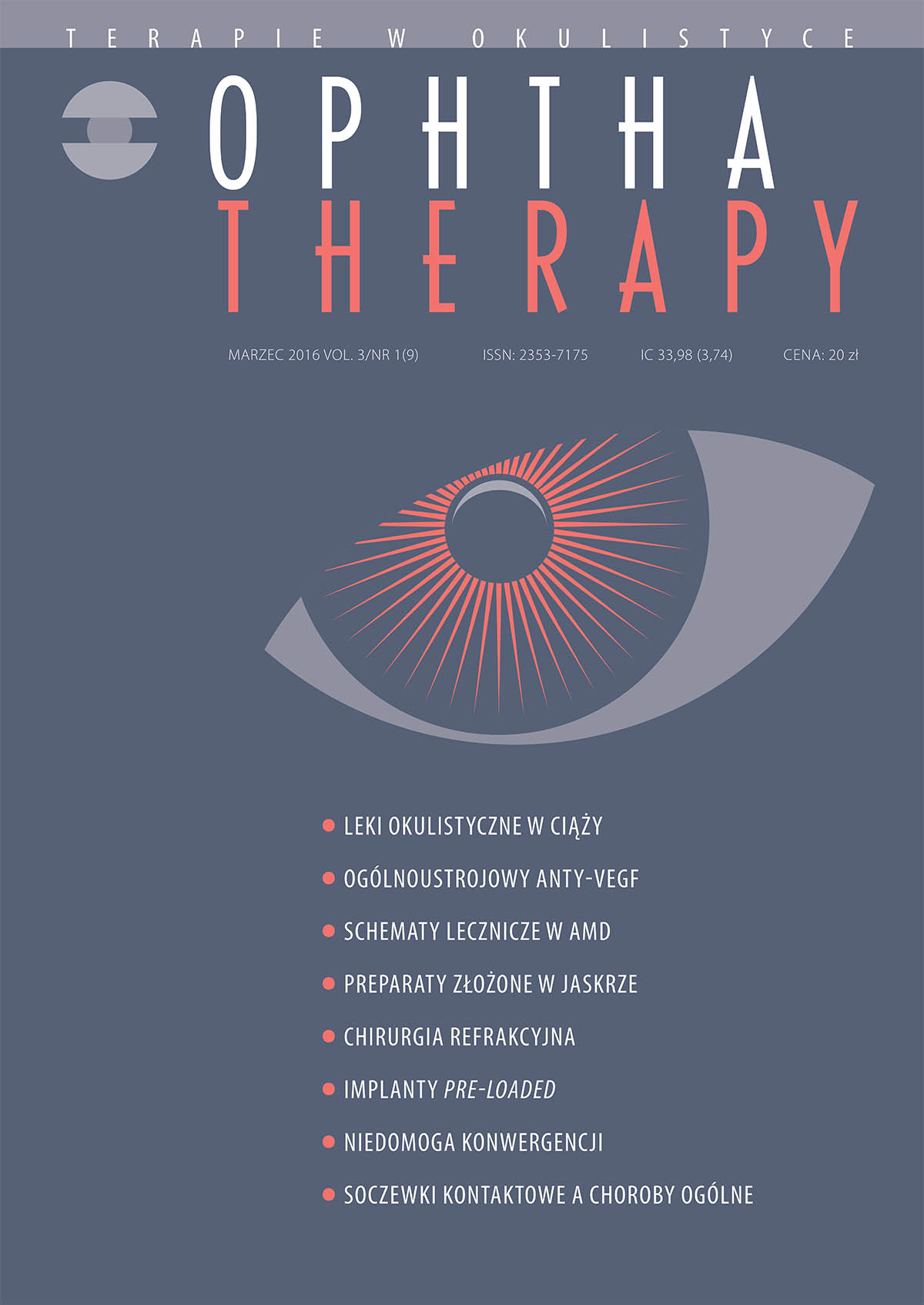Pre-loaded IOL delivery system – features of the new UltraSert system
Main Article Content
Abstract
Objective: To present first experiences with implantation of intraocular lenses (IOL) with the use of Alcon UltraSert Pre-loaded Delivery System.
Materials and methods: The study included a total of 20 patients suffering from uncomplicated cataract. The were divided into 2 groups. All the patients underwent routine phacoemulsification with implantation of IOL using UltraSert System or Monarch III Cartridge and Royal injector. The patients were implanted Acrysoft IOL SN60WF (20–24 D). The selection of the method was randomized. Efficacy, safety and benefits of the selected methods were then assessed. Control studies were conducted on the 1st and 7th day after the procedure.
Results: All the procedures ran without any complications. The use of UltraSert Pre-loaded Delivery System involved fewer manipulations to deliver the IOL correctly and was shortened on average by 10. No damage to the IOL was observed.
Conclusions: The use of the Pre-loaded Delivery System is simple and intuitive. The learning curve for the procedure is short, mistakes are infrequent. The use of the Pre-loaded Delivery System seems to be a very good solution for the future.
Downloads
Article Details

This work is licensed under a Creative Commons Attribution-NonCommercial-NoDerivatives 4.0 International License.
Copyright: © Medical Education sp. z o.o. License allowing third parties to copy and redistribute the material in any medium or format and to remix, transform, and build upon the material, provided the original work is properly cited and states its license.
Address reprint requests to: Medical Education, Marcin Kuźma (marcin.kuzma@mededu.pl)
References
2. Alio J, Rodriguez-Prats JL, Galal A. Advances in microincision cataract surgery intraocular lenses. Curr Opin Ophthalmol. 2006; 17: 80-93.
3. Lundström M, Barry P, Henry Y et al. Evidence-based guidelines for cataract surgery: guidelines based on data in the European Registry of Quality Outcomes for Cataract and Refractive Surgery database. J Cataract Refract Surg. 2012; 38: 1086-93.
4. Wenzel M, Kohnen T, Scharrer A et al. Ambulante Intraokularchirurgie 2012: Ergebnisse der Umfrage von BDOC, BVA, DGII und DOG. Ophthalmo-Chirurgie. 2013; 25: 213-22.
5. Bellucci R. An introduction to intraocular lenses: Material, optics, haptics, design and aberration. In: Guell JL (ed). Cataract. ESASO Course Series. Karger, Basel 2013: 38-55.
6. Lane SS, Burgi P, Milios GS et al. Comparison of the biomechanical behavior of foldable intraocular lenses. J Cataract Refract Surg. 2004; 30: 2397-402.
7. Bozukova D, Pagnoulle C, Jerome C. Biomechanical and optical properties of 2 new hydrophobic platforms for intraocular lenses. J Cataract Refract Surg. 2013; 39: 1404-14.
8. Cooper BA, Holekamp NM, Bohigian G et al. Case-controlstudy of endophthalmitis after cataractsurgery comparing scleral tunnel and clear corneal wounds. Am J Ophthalmol. 2003; 136: 300-5.
9. Colleaux KM, Hamilton WK. Effect of prophylactic antibiotics and incision type on the incidence of endophthalmitis after cataract surgery. Can J Ophthalmol. 2000; 35: 373-8.
10. Nagaki Y, Hayasaka S, Kadoi C et al. Bacterial endophthalmitis aftersmall-incision cataractsurgery. Effect of incision placement and intraocular lens type. J Cataract Refract Surg. 2003; 29: 20-6.
11. McDonnell PJ, Taban M, Sarayba M et al. Dynamic morphology of clear corneal cataract incisions. Ophthalmology. 2003; 110: 2342-8.
12. Taban M, Rao B, Reznik J et al. Dynamic morphology of sutureless cataract wounds – effect of incision angle and location. Surv Ophthalmol. 2004; 49(suppl 2): S62-72.
13. Miller J, Scott IU, Flynn HW Jr et al. Acute-onset endophthalmitis after cataractsurgery (2000–2004): incidence, clinicalsettings and visual acuity outcomes after treatment. Am J Ophthalmol. 2005; 139: 983-7.
14. Mayer E, Cadman D, Ewings P et al. A 10-year retrospective survey of cataract surgery and endophthalmitis in a single eye unit: injectable lenses lower the incidence of endophthalmitis. Br J Ophthalmol. 2003; 87: 867-9.
15. Zaluski S, Clayman HM, Karsenti G et al. Pseudomonas aeruginosa endophthalmitis caused by contamination of the internal fluid pathways of a phacoemulsifier. J Cataract Refract Surg. 1999; 25: 540-5.
16. Leslie T, Aitken DA, Barrie T et al. Residual debris as a potential cause of postphacoemulsification endophthalmitis. Eye. 2003; 17: 506-12.

